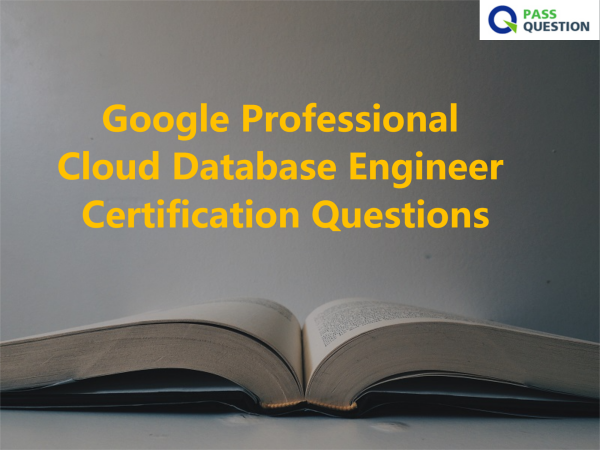Google Professional Cloud Database Engineer Certification Questions
Preparing for the Professional Cloud Database Engineer certification can improve your proficiency in database migration and management in the cloud. PassQuestion provides Google Professional Cloud Database Engineer Certification Questions to help you prepare for the Google Cloud Certified Professional Cloud Database Engineer exam by testing your abilities and knowledge. Our Google Professional Cloud Database Engineer Certification Questions allow you to assess your knowledge before taking the final exam. You may rest assured that you will find everything you need to pass the Google Cloud Certified - Professional Cloud Database Engineer exam on your first try.

Professional Cloud Database Engineer Certification
A Professional Cloud Database Engineer is a database professional with two years of Google Cloud experience and five years of overall database and IT experience. The Professional Cloud Database Engineer designs, creates, manages, and troubleshoots Google Cloud databases used by applications to store and retrieve data. The Professional Cloud Database Engineer should be comfortable translating business and technical requirements into scalable and cost-effective database solutions.
About this certification exam
Length: 2 hours
Registration fee: $200 (plus tax where applicable)
Language: English
Exam format: Multiple choice and multiple select
Exam Delivery Method:
a. Take the online-proctored exam from a remote location.
b. Take the onsite-proctored exam at a testing center.
Prerequisites: None
Recommended experience: 5+ years of overall database and IT experience, including 2 years of hands-on experience working with Google Cloud database solutions
Exam Content
The Professional Cloud Database Engineer exam assesses your ability to:
Design scalable and highly available cloud database solutions
Manage a solution that can span multiple database solutions
Migrate data solutions
Deploy scalable and highly available databases in Google Cloud
View Online Google Professional Cloud Database Engineer Free Questions
Your company wants to migrate its MySQL, PostgreSQL, and Microsoft SQL Server on-premises databases to Google Cloud. You need a solution that provides near-zero downtime, requires no application changes, and supports change data capture (CDC). What should you do?
A.Use the native export and import functionality of the source database.
B.Create a database on Google Cloud, and use database links to perform the migration.
C.Create a database on Google Cloud, and use Dataflow for database migration.
D.Use Database Migration Service.
Answer: B
You are running a large, highly transactional application on Oracle Real Application Cluster (RAC) that is multi-tenant and uses shared storage. You need a solution that ensures high-performance throughput and a low-latency connection between applications and databases. The solution must also support existing Oracle features and provide ease of migration to Google Cloud. What should you do?
A.Migrate to Compute Engine.
B.Migrate to Bare Metal Solution for Oracle.
C.Migrate to Google Kubernetes Engine (GKE)
D.Migrate to Google Cloud VMware Engine
Answer: A
You are choosing a new database backend for an existing application. The current database is running PostgreSQL on an on-premises VM and is managed by a database administrator and operations team. The application data is relational and has light traffic. You want to minimize costs and the migration effort for this application. What should you do?
A.Migrate the existing database to Firestore.
B.Migrate the existing database to Cloud SQL for PostgreSQL.
C.Migrate the existing database to Cloud Spanner.
D.Migrate the existing database to PostgreSQL running on Compute Engine.
Answer: B
Your organization is currently updating an existing corporate application that is running in another public cloud to access managed database services in Google Cloud. The application will remain in the other public cloud while the database is migrated to Google Cloud. You want to follow Google-recommended practices for authentication. You need to minimize user disruption during the migration. What should you do?
A.Use workload identity federation to impersonate a service account.
B.Ask existing users to set their Google password to match their corporate password.
C.Migrate the application to Google Cloud, and use Identity and Access Management (IAM).
D.Use Google Workspace Password Sync to replicate passwords into Google Cloud.
Answer: C
You are configuring the networking of a Cloud SQL instance. The only application that connects to this database resides on a Compute Engine VM in the same project as the Cloud SQL instance. The VM and the Cloud SQL instance both use the same VPC network, and both have an external (public) IP address and an internal (private) IP address. You want to improve network security. What should you do?
A.Disable and remove the internal IP address assignment.
B.Disable both the external IP address and the internal IP address, and instead rely on Private Google Access.
C.Specify an authorized network with the CIDR range of the VM.
D.Disable and remove the external IP address assignment.
Answer: B
You are designing a payments processing application on Google Cloud. The application must continue to serve requests and avoid any user disruption if a regional failure occurs. You need to use AES-256 to encrypt data in the database, and you want to control where you store the encryption key. What should you do?
A.Use Cloud Spanner with a customer-managed encryption key (CMEK).
B.Use Cloud Spanner with default encryption.
C.Use Cloud SQL with a customer-managed encryption key (CMEK).
D.Use Bigtable with default encryption.
Answer: C
- TOP 50 Exam Questions
-
Exam
All copyrights reserved 2025 PassQuestion NETWORK CO.,LIMITED. All Rights Reserved.

